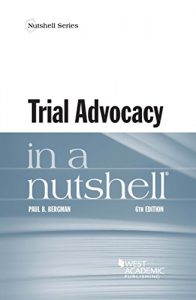Trial Advocacy in a Nutshell was one of the first works to analyze and illustrate discrete courtroom skills and techniques in the context of principles of persuasion. The expanded and updated Sixth Edition incorporates a number of features that make the book more indispensable for trial lawyers than ever. Part 1 provides a concrete and detailed guide for developing “argument-centered narratives,” which are credible stories that support advocates’ desired inferences. Part 1 concludes with an important new chapter that explains the role of argument-centered narratives in the context of arbitrations, mediations and settlement negotiations. Part 2 analyzes and illustrates strategies, techniques and rules for presenting argument-centered narratives effectively during all phases of trial, from opening statement to closing argument, with a separate chapter analyzing effective examination strategies for expert witnesses.
The Sixth Edition expands the coverage of the Federal Rules of Evidence, explaining and illustrating how to lay foundations that satisfy evidentiary requirements set forth in the rules. Foundational requirements for electronic records and many other types of exhibits, including those prepared by courtroom graphics experts, also gain additional prominence in the new edition. Some of the illustrative examinations and arguments in the new edition are drawn from trials that took place in a variety of eras. For example, the chapter on closing argument compares arguments made in the murder trial of Euphiletus (Greece, circa 400 B.C.) with those made in the trial of OJ Simpson (1995). Among the other trials from which illustrations are drawn are those of the Rosenbergs (the so-called “atomic spies,” 1953), the Menendez Brothers (1991), the “Hillmon case” (1890’s), and the “Triangle Shirtwaist Fire” case (1911). The illustrations from these cases are not only interesting, but also suggestive of enduring principles of persuasion.
Another feature of the Sixth Edition are analyses of examples drawn from classic courtroom films such as Anatomy of a Murder, 12 Angry Men and My Cousin Vinny. Combined with these new and expanded features, the Sixth Edition preserves many of the features that have made the book so valuable to readers. For example, the book continues to carefully explain principles, illustrate them, and analyze the illustrations. Popular “models,” such as the Credibility Model and the Safety Model of Cross Examination, also appear in the new edition. Also carried forward is the book’s light tone which makes it not only useful but also a good read.
The Sixth Edition expands the coverage of the Federal Rules of Evidence, explaining and illustrating how to lay foundations that satisfy evidentiary requirements set forth in the rules. Foundational requirements for electronic records and many other types of exhibits, including those prepared by courtroom graphics experts, also gain additional prominence in the new edition. Some of the illustrative examinations and arguments in the new edition are drawn from trials that took place in a variety of eras. For example, the chapter on closing argument compares arguments made in the murder trial of Euphiletus (Greece, circa 400 B.C.) with those made in the trial of OJ Simpson (1995). Among the other trials from which illustrations are drawn are those of the Rosenbergs (the so-called “atomic spies,” 1953), the Menendez Brothers (1991), the “Hillmon case” (1890’s), and the “Triangle Shirtwaist Fire” case (1911). The illustrations from these cases are not only interesting, but also suggestive of enduring principles of persuasion.
Another feature of the Sixth Edition are analyses of examples drawn from classic courtroom films such as Anatomy of a Murder, 12 Angry Men and My Cousin Vinny. Combined with these new and expanded features, the Sixth Edition preserves many of the features that have made the book so valuable to readers. For example, the book continues to carefully explain principles, illustrate them, and analyze the illustrations. Popular “models,” such as the Credibility Model and the Safety Model of Cross Examination, also appear in the new edition. Also carried forward is the book’s light tone which makes it not only useful but also a good read.






